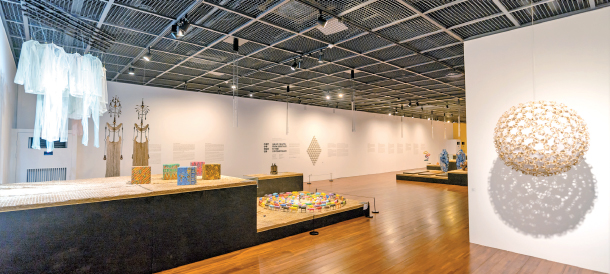Asean artists show off traditional crafts: Inherited techniques inform the creation of contemporary artwork

The “Asean Crafts: From Heritage to the Contemporary” exhibition is on view at the Asean Culture House in Haeundae District, Busan. [KOREA FOUNDATION]
While Asean designers hosted fashion shows at the Asean-Korea Fashion Week and restaurateurs served up traditional dishes at the Food Street, the Asean Culture House chose to celebrate the special occasion by putting on an exhibition of over 200 traditional and contemporary crafts from the 10 Asean states.
“‘Asean Crafts: From Heritage to the Contemporary’ aims to introduce Asean crafts, which are not well-known in Korea,” explained the exhibition’s curator Park Jung-won, who teaches ceramics at Kookmin University. “We wanted visitors to experience the singularity of Asean culture, and observe how each country’s unique tradition interacts with the present and continues evolving toward the future.”

“Bali Tekebang,” top, by Anniketyni Madian (Malaysia), “Terra Formed Bottle,” middle, by Martie Geiger Ho (Brunei) and “After the War,” bottom, by Bui Cong Khanh (Vietnam). [ASEAN CULTURE HOUSE]
Crafts reveal a lot about the country of their origin, making them a good medium to facilitate cultural exchange. Not only do their imagery and function shed light onto cultural and religious tradition, but the materials they’re made of reflect the climate and natural resources commonly found in those regions.
“You can see that the Asean states use lacquer to prevent damages from humidity, while creating clothing and accessories to fight off heat and rain,” Park said.
Since artisans often pass down their techniques to their family, crafts also offer an insight into not only the lives of their maker, but of the generations preceding them. Thai artist Korakot Aromdee, who creates elegant sculptures and lamps using woven bamboo and hemp ropes, is said to have learned the techniques from his grandfather, an expert kite crafter.
Like Aromdee, all craftspeople should take up the responsibility of incorporating local and traditional techniques and evolving them to meet modern challenges and enrich their cultural heritage, Park believes.
“Asean crafts are made to a very high quality, as they have been created by people who merged craftsmanship and beauty while adjusting to the natural environment of Southeast Asia,” Park said. “I hope that we can also learn from ‘Asean Crafts’ on how to recreate and reinterpret Korean traditional crafts to adapt to the changing times.”
Works from “Asean Crafts” were recently taken up to North Chungcheong to be presented to wider audiences at the Asean Pavilion of the Cheongju Craft Biennale, which ended last week.
Asean Culture House, a Busan-based facility operated by the public diplomacy organization Korea Foundation, hosts Asean-related cooking, language and arts events all year round at its facility in Haeundae District. The venue was conceived as a direct result of the Korea-Asean summit in 2014 under the Ministry of Foreign Affairs’ initiative to facilitate cultural exchange with the Asean members. Korea was the first non-Asean state to have its own Asean Culture House when the building opened in 2017.
The Culture House is currently running the Asean Cinema Week 2019 and a permanent exhibition of Southeast Asian objects in “Asean Ways of Life.” It is also getting ready to open the Bazaar Mekong from this Friday, where it will sell handicrafts from Cambodia, Laos, Myanmar, Thailand and Vietnam.
BY KIM EUN-JIN [kim.eunjin1@joongang.co.kr]
“Asean Crafts” re-opens after temporary closure on Wednesday and runs through Jan. 15. It is open from 10 a.m. to 6 p.m. from Tuesdays to Fridays, and until 7 p.m. on weekends. Entry is free.










with the Korea JoongAng Daily
To write comments, please log in to one of the accounts.
Standards Board Policy (0/250자)